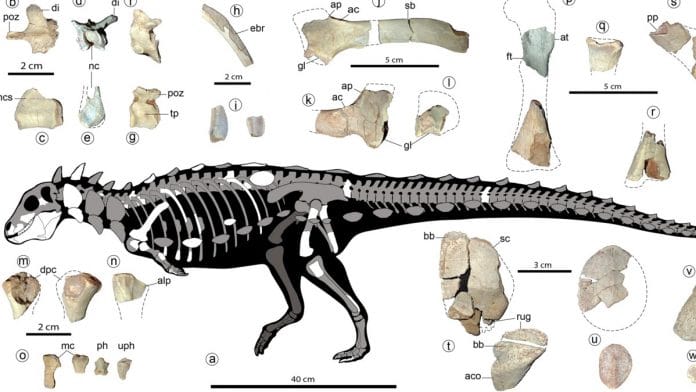New Delhi: Scientists have found a new species of a small armoured dinosaur in southern Argentina dating back to over a hundred million years, that likely walked upright on its back legs.
Named Jakapil kaniukura, the creature would have been well-protected with rows of bony, disc-shaped armour along its neck and back, and down to its tail. It measured about 1.5 metres long and weighed just about 4-7 kg, about the same as an average house cat.
The fossils of the creature, including a partial skeleton of it, along with 15 tooth fragments of a leaf-like shape, was found in a dam in Patagonia in Rio Negro province’s La Buitrera palaeontological zone. The discovery is the first-of-its-kind of an armoured dinosaur from the Cretaceous period in South America.
It is part of the thyreophoran dinosaur group, that includes the likes of stegosaurus, known for its bony back plates and spiky tail, and tank-like ankylosaurus, covered in armour and wielding a club-like tail. Jakapil resembles a primitive form of thyreophoran that lived much earlier, making it a surprise that it dated from the Cretaceous. Read more.
No ice near Martin equator
NASA’s Mars Insight mission has revealed that the top 300 meters of the sub-surface beneath the landing site near the Martian equator contains little or no ice. The lander also found that the Mars’ crust is weak and porous, and the sediments are not well-cemented.
Researchers from the University of California San Diego say that this contradicts a leading idea about what happened to the water on Mars.
The red planet may have harbored oceans of water early in its history. Many experts suspected that much of the water became part of the minerals that make up the cement underground. However, authors say that the Martian rock is not full of cement.
The lack of cemented sediments suggests a water scarcity 300 meters below InSight’s landing site near the equator. The below-freezing average temperature at the Mars equator means that conditions would be cold enough to free water if it were there.
Many planetary scientists have long suspected that the Martian subsurface would be full of ice. Their suspicions have melted away. Still, big ice sheets and frozen ground ice remain at the Martian poles. Read more.
Also Read: Scientists say it’s theoretically possible to communicate with extraterrestrial beings
How humans got their speech
Researchers from Kyoto University, Anglia Ruskin University, and University of Cambridge suggest that chimpanzees and other non-human primates cannot speak or sing like humans because, changes to human vocal anatomy, specifically to the larynx or “voice box” provided the stable, clear voices we use to communicate.
These changes involve loss of a specific part of the vocal cords in our larynx. Most primates have thin, ribbon-like vocal membranes rising out of their vocal cords, and humans have lost this feature.
The change, along with our loss of the air sacs, seen in chimpanzees and other apes, provided the more stable and controllable voice pitch, and less noisy voice quality, that humans use during singing or speech.
Thus, seemingly paradoxically, the increased complexity of human communication involved a simplification of our vocal anatomy.
Computer modelling showed that vocal membranes allow primates to create loud, high-pitched vocalisations, but also make their voices unstable and shrieky.
According to researchers, the melodious quality of the human voice is a direct result of our loss of these membranes. Read more.
World’s biggest ice sheet could cause several metres of sea level rise with global warming
The world’s biggest ice sheet could cause “several meters” of sea-level rise over centuries if the global temperature rises more than 2 degree celsius, a study warns.
Researchers at Durham University concluded that if global greenhouse emissions remain high, the melting East Antarctic Ice Sheet (EAIS) could cause nearly half a metre of sea-level rise by 2100.
If emissions remain high beyond that, the EAIS could contribute around one to three meters to global sea levels by 2300, and two to five meters by 2500, they said.
However, if emissions were dramatically reduced, EAIS could contribute around two centimeters of sea level rise by 2100, according to the assessment.
This would represent far less than the ice loss expected from Greenland and West Antarctica. The research team, which included scientists from the UK, Australia, France, and the US analysed how the ice sheet responded to past warm periods when making their predictions.
They ran computer simulations to model the effects of different greenhouse gas emission levels and temperatures on the ice sheet by the years 2100, 2300, and 2500.
They found evidence to suggest that three million years ago, when the temperatures were around 2-4 degree celsius higher than the present, part of the EAIS “collapsed and contributed to several meters of sea-level rise”. Read more.
(Edited by Siddarth Muralidharan)
Also Read: 66-year-old U.S. man is the fifth in the list, but the oldest patient to be cured of HIV






